Despite the budget problems that plague NASA, there are more opportunities than ever before to get your projects into space. Motivated amateurs are building high-altitude balloons, high-powered rockets, and even miniature satellites called CubeSats that can hitch a ride on commercial launches.
A venerable but often overlooked platform for space experimentation is government suborbital rocket flights. Also called sounding rockets, these retired missiles don't have enough energy to achieve orbit, but they can still soar well into space (from 100 to 1000km) before falling back to earth. Because they exit the atmosphere and coast in zero-g for five to ten minutes before reentry, they're ideal for many experiments: astronomy in wavelengths that are absorbed by the earth's atmosphere, studying ozone, aurora, and other aspects of the space environment, fluid dynamics in zero-g, even testing models of re-entry vehicles. The flights may be brief, but they are much less expensive than a traditional satellite launch. Rockets are regularly flown from NASA facilities at Poker Flats in Alaska, White Sands in New Mexico, and Wallops Flight Facility in Virginia, as well as other sites around the world. But unless you have official connections and deep pockets, access to this resource is limited.
The Colorado Space Grant Consortium (COSGC) and NASA Wallops Flight Facility (WFF) have been working to bring this resource to students around the country through their RockON! program. Instead of the more traditional (and expensive) model where you get the whole rocket to yourself, RockON! gives student teams slices of a rocket, mentors them in the art of space experiment construction, then flies a bunch of experiments at the same time.
The program, now in its sixth year, is run every summer and has three levels. Beginners start with the RockON! workshop, held at NASA's Wallops Flight Facility in Virginia. The week-long workshop (a bargain at under $1000 per 3-student team) gives students a crash course in space experimentation. This includes basics such as soldering and programming, learning about the space environment, and training in how to design hardware that can survive the 40g launch loads and high spin rates the experiments will be subjected to during the flight.
During all of this, the student teams build their own experiment module from a provided kit, perform subsystem and system-level tests, participate in reviews, integrate their payload into the larger rocket, and watch as the assembled rocket undergoes flight qualification tests at the NASA facility.
At the end of the week, the rocket is trucked out to the coastal launch site, attached to the solid rocket motors that will propel it into space, and mounted to the launch rail. After numerous range safety and weather checks and a four-hour countdown, the rocket is launched! The first stage burns for two seconds and separates, by which time the 40' rocket is already several km up and approaching the speed of sound. After coasting for a few seconds, the second stage ignites and burns for another minute, propelling the rocket on a parabolic course that will take it well out of the atmosphere. To stabilize the rocket, the fins are canted to give it a high rate of spin before it leaves the atmosphere; this spin can be removed later if required by deploying "despin" weights. After a quiet five-minute coast to 100km and back, the rocket reenters the atmosphere (getting hot but not enough to burn up), deploys a parachute at 20,000', descends for another 20 minutes, and splashes down in the Atlantic. The rocket is sealed and floats, and is recovered by ship the same day. The students then get to de-integrate their payloads, and retrieve the SD cards with the flight data from their experiments.
The next level up is RockSat-C, which uses a similar rocket and mounting hardware as the RockON! workshop, but allows students to design their own experiments. This is a longer process which starts the fall before next summer's launch. During the school year, students hold frequent teleconferences with NASA personnel and participate in an industry-standard series of design reviews before, during, and after their hardware is designed and built. Along with the freedom to design their own experiments, the students must learn and follow the extensive safety rules enforced by the rocket program, and be able to prove that to the NASA reviewers. As with the RockON! workshop, the student teams travel to NASA WFF in the summer to test and integrate their payloads into the larger rocket, fly their experiments, and retrieve and report on their findings.
ReplaceMeOpen
ReplaceMeClose
The top level of the program is RockSat-X, which also allows students to propose, design, and build their own experiments, but for these flights the rocket hardware sheds its skin once it leaves the atmosphere, exposing the student experiments directly to space. This allows a whole new level of experiment possibilities, and students have flown atmospheric samplers, deployable structures, and even ejected small re-entry vehicles. Because the environment is much more severe, the requirements and regulations are necessarily more stringent. But one of the benefits of the sounding rocket program itself is the ability to test out innovative hardware and techniques relatively inexpensively and safely. If you have an interesting proposal, the NASA Wallops personnel will likely be game to try it.
For more information on the RockON! program, contact the Colorado Space Grant Consortium at http://spacegrant.colorado.edu/. And stay tuned; the new breed of commercial spacecraft that will soon be taking tourists on zero-g rides will all have cargo space for experiments as well. Soon you may be able to build an experiment and ride along with it.
More information:
RockON! 2013 flyer (pdf)
A NASA press release listing this year's RockSat-X participants and experiments.
NASA Sounding Rocket Handbook (Gives a good overview of the technical and programmatic requirements when working on a government rocket flight.)
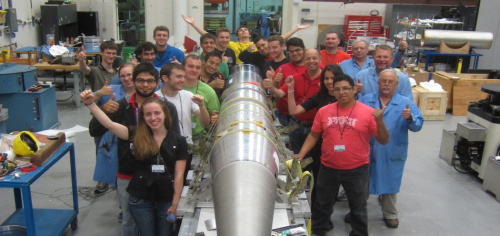
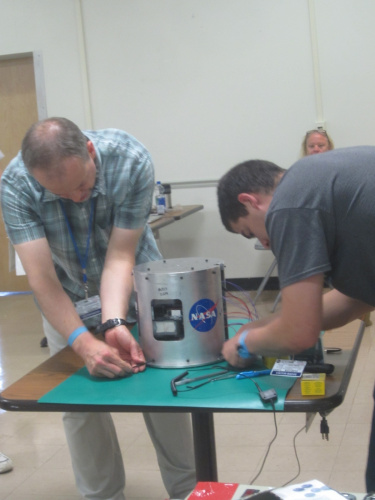
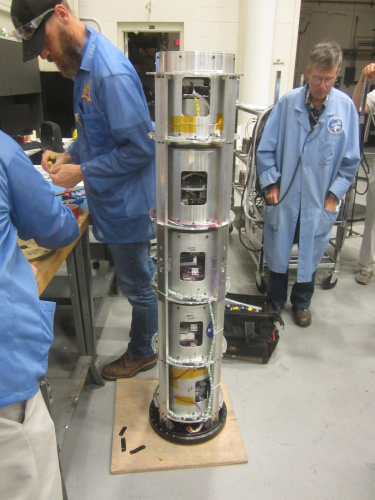
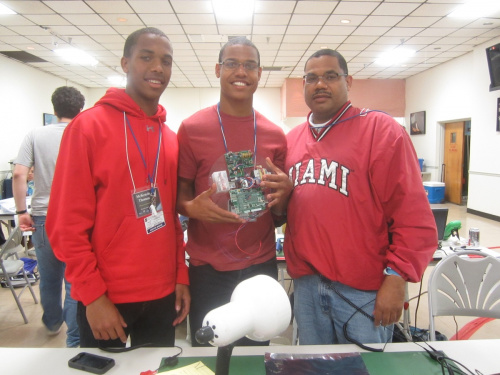
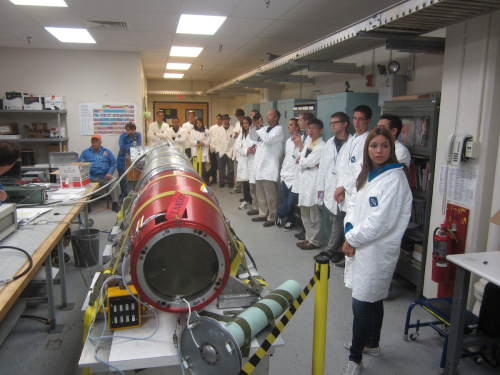






This is something I want to do! #BucketList. But what to send???
Too bad John Carmack's attempt to create a private option to the government sounding rocket ran out of cash.
good!
Ha I love that our team's video (RockSat-X experience made it!)
I think your math/times are a little off. For the rocket to burn for only 2 seconds and only be approaching the speed of sound it would at best only be about 330 meters high. And if after 2 sec it was at 2 km it would equate to an acceleration of about 100g. Just sayin'.
Agreed Tony. Some guy called Newton said that s=ut + (at^2)/2. Taking a maximum acceleration of 40g gives about 400 m/s^2.
u=0 since launch is from rest.
s= 0 + (400 * 4)/2= 800 m.
No slouch but 800m != kilometers.
Don. 40g is the maximum acceleration. While what you say is true in general there is no way it can get kilometers up in 2 seconds without busting the 40g limit.
American sounding rocket. Unguided solid propellant single stage rocket using a military surplus M112 Hawk rocket motor. The motor was a dual thrust burner with a boost phase of 5 seconds and a sustainer phase of approximately 21 seconds. The rocket accelerated the payload then for 26 seconds with peak acceleration during the boost phase of 21g. A payload mass of 100 kg could be carried to an apogee of approximately 110 km.
So even if the peak accelleration was sustained from start to finish (impossible) the boost height would be approx 2.577 km.
I dont see why you would put "(impossible)" in your last line here. As stated by DonQ above, not only does the force provided by the rocket motor increase gradually, but the weight of the complex as a whole decreases. This results in a fairly consistent acceleration, which was done by design when these launch vehicles were developed (operation BumbleBee) so that their payload sensors would survive, while minimizing launch-to-intercept times. (note: I am certain EXACTLY 40g is unlikely, but an average of ~38g is quite possible)
Another point to others in this thread, the author did place the two words " and separates" within that sentence, an action that occurs a good 1 to 3 seconds after burnout has completed (which the video shows first stage burn to be a bit longer than 2 seconds, just counting in my head). So since we are now talking about the distance traveled during the burn as well as the distance traveled while coasting, I do not think the author was too far off in their statement.
Not posting aggressively, always happy to see people fact checking. I do believe the author should have put that the first stage lasts about 5 seconds.
EDIT: As I know for a fact that a terrier booster was used (at least in the video), the facts about the terrier booster here: SOURCE. should be applicable. 6 second burn 3.1km burnout altitude
Your numbers are only good for constant acceleration, and with no friction. Fuel burns, rocket gets lighter, a=F/m so acceleration goes up (and the integral gets more complicated). Also, many solid fuel rockets are burned in a way where the burning surface area increases during the burn. So not only does m decrease, but also F increases, sometimes by many multiples. Low sub-sonic air friction increases approx with the square of velocity, but decreases with altitude. Super and trans-sonic friction is not so simple. Can't do those numbers in my head anymore, but I suspect that they're different than what you got. Just sayin'.
I'll have to look at the spec sheet of the launch but this thing THUMPS off the pad. The engines of these rockets are surplus surface to air missiles :)
I had friends that did this as their senior design project (I helped out a bit). It is a really awesome program. If you can be part of it, do it.